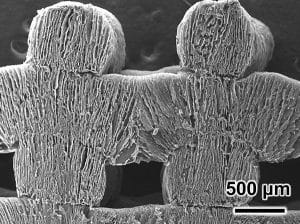Improvements, Still
A new 3D printable substrate improves solar distillation by an order.

As the world warms and the climate changes, water shortages are to be expected. Not only does warmer weather require more water for people, animals, plants, and industry...but also, where the water appears, where and how it flows, and the quality of the water is bound to change.1, 2
Since so much of our water is trapped in salty oceans, desalination is a important field of research (see our article here).5,6
Solar stills are an old idea. They have been around for thousands of years. They were used on survival rafts during WWII. They are simple: a small pool that contains water to be distilled, a cover that captures heat from the sun and acts as a barrier to evaporating water, and a way to collect the pure water that drips off the end of the top barrier. Camping nerds often make them by digging a hole in wet ground and putting a vapour barrier and bottle in the hole to catch water as it evaporates. You can make a primitive solar still with two plastic Coke bottles and a knife.
Solar stills work and are cheap to make and operate, but are usually a low-volume proposition: good for campers, castaways, and preppers, but, commonly, not nations. Famously among large and early evaporative-basin plants, a 4450 square metre pit distiller operated in the late 1800s in the arid regions of northern Chile, supplying up to 23 tons of water a day to miners. The largest currently-operating "basin-style" solar distiller we could find produces 26 cubic meters daily.7 These days, large-scale solar water desalination usually uses photovoltaics and powered techniques like reverse osmosis or other membrane technologies. A large such photovoltaic plant in Egypt produces 7300 cubic metres of water a day.8
In a paper published July 2nd, 2025, a group of researchers described an innovation that can be applied to this old technology: a 3D-printed aerogel sponge that can be put in the pool of source water to soak it up and increase the evaporation rate.9, 10
What's aerogel? For an analogy, think of sponge toffee: a solid structure that is mostly air, but with a rigid structure. Now, instead of sugar and bubbles, imagine the object is made of carbon nanotubes and cellulose nanofibres. The nanotubes conduct heat very well, and the cellulose adds structural integrity and "hydrophilic" (water absorbing) behaviour. So you get a sponge with a huge internal surface area in a small volume, the ability to suck up water, and the ability to pass heat along internally very quickly. It's a perfect setup for rapid evaporation.
The application is almost painfully simple: the aerogel sits above a pool of seawater. It is covered with a plastic dome. Water evaporates, hits the dome, and rolls down the surface to be collected at the edges. That's it. You fill it with seawater and set it in the sun.
The aerogel is designed to resist contamination from the effluent left behind after distilling. According to the researchers, simple rinsing is enough to keep it clean and functioning optimally.
Most important: the researchers claim it should scale upwards easily in size. We don't yet know how far it will scale or how cost-effective it will be, but one thing is certain: it should easily surpass the output of the Chilean pit still from the 1800s.
We suggest you read the summary and original papers (our notes 9 and 10). We've undersold the work here: as a feat in materials engineering, this aerogel is pretty impressive.
Especially in a thirsty world.
Reading
- Rosińska, W., K. Przestrzelska, K. Wartalska, M. Grzegorzek, M. Wdowikowski, Z. Czerska, and B. Kaźmierczak. "Climate change's ripple effect on water supply systems and water quality." Science of the Total Environment (2024) .
- Asresu, A. T., E. Furlan, F. Horneman, F. Zennaro, N. D. Nguyen, S. Torresan, A. Critto, and A. Marcomini. "A systematic review of climate change impacts on water resources." Environmental Research (2025) .
- Mehmood, Hamid. Bibliometrics of Water Research: A Global Snapshot. UNU-INWEH Report Series, Issue 6. Hamilton: United Nations University Institute for Water, Environment and Health, 2019.
- Basu, Mrittika, and Rajarshi Dasgupta. "Where Do We Stand Now? A Bibliometric Analysis of Water Research in Support of the Sustainable Development Goal 6." Water 13, no. 12 (2021): 3591. https://doi.org/10.3390/w13243591.
- Zolghadr-Asli, B. “A Review of Limitations and Potentials of Desalination: A Sustainability Perspective.” Environmental Science and Pollution Research (2023).
- Sabour, S. M. J. S. “A Comprehensive Review of Major Water Desalination Techniques and Mineral Extraction from Saline Water.” Separation and Purification Technology 2024.
- “Solar Distillation Plant - an Overview | ScienceDirect Topics.” Accessed July 3, 2025. https://www.sciencedirect.com/topics/engineering/solar-distillation-plant.
- Nova, Redazione Agenzia. “Egypt: World’s Largest Solar Desalination Plant Opened.” Agenzia Nova (blog), December 12, 2024. https://www.agenzianova.com/en/news/Egypt-inaugurates-world%27s-largest-solar-powered-desalination-plant/.
- American Chemical Society. “This Spongy Material and the Sun’s Power Remove Salt from Seawater.” Accessed July 3, 2025. https://www.acs.org/pressroom/presspacs/2025/july/this-spongy-material-and-the-suns-power-remove-salt-from-seawater.html.
- Zhao, Xiaomeng, Yunfei Yang, Xuemin Yin, Zhuo Luo, Kit-Ying Chan, and Xi Shen. “Size-Insensitive Vapor Diffusion Enabled by Additive Freeze-Printed Aerogels for Scalable Desalination.” ACS Energy Letters, July 2, 2025, 3419–29. https://doi.org/10.1021/acsenergylett.5c01233.
